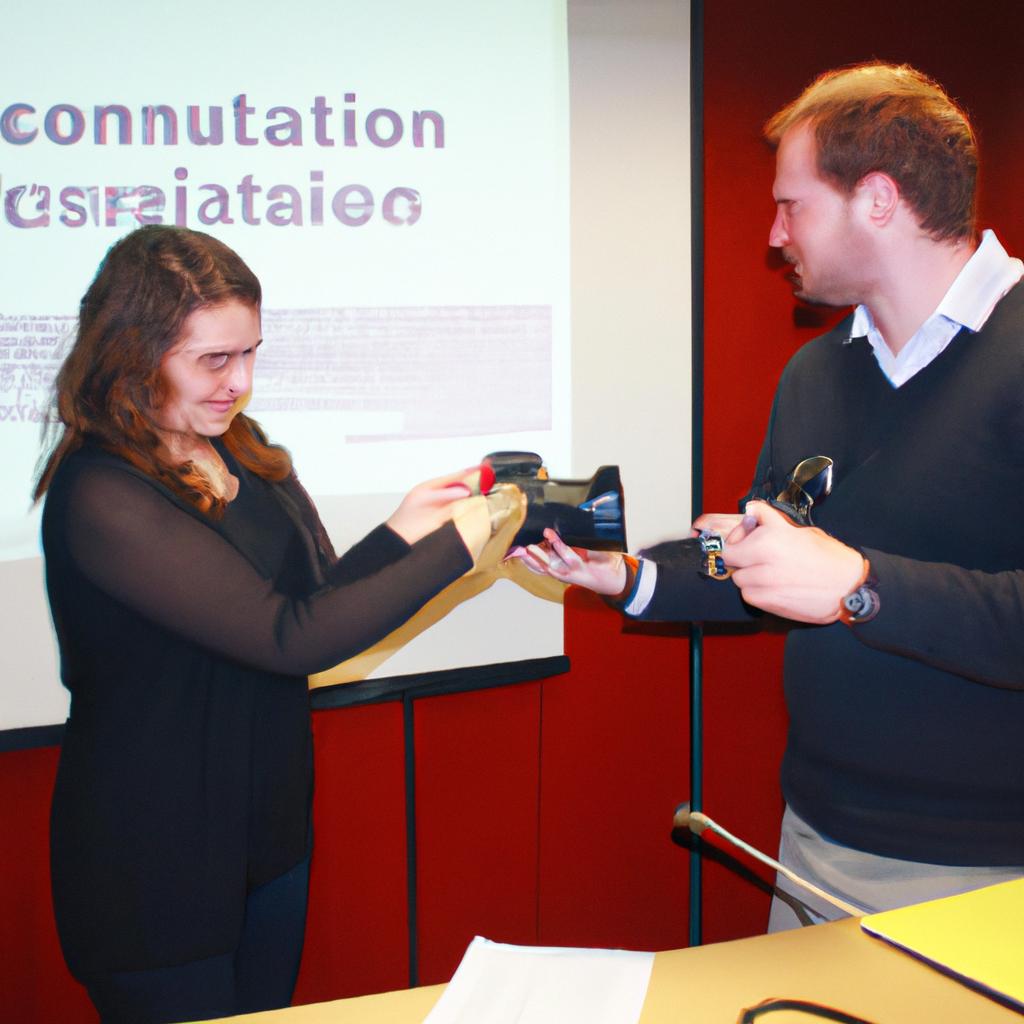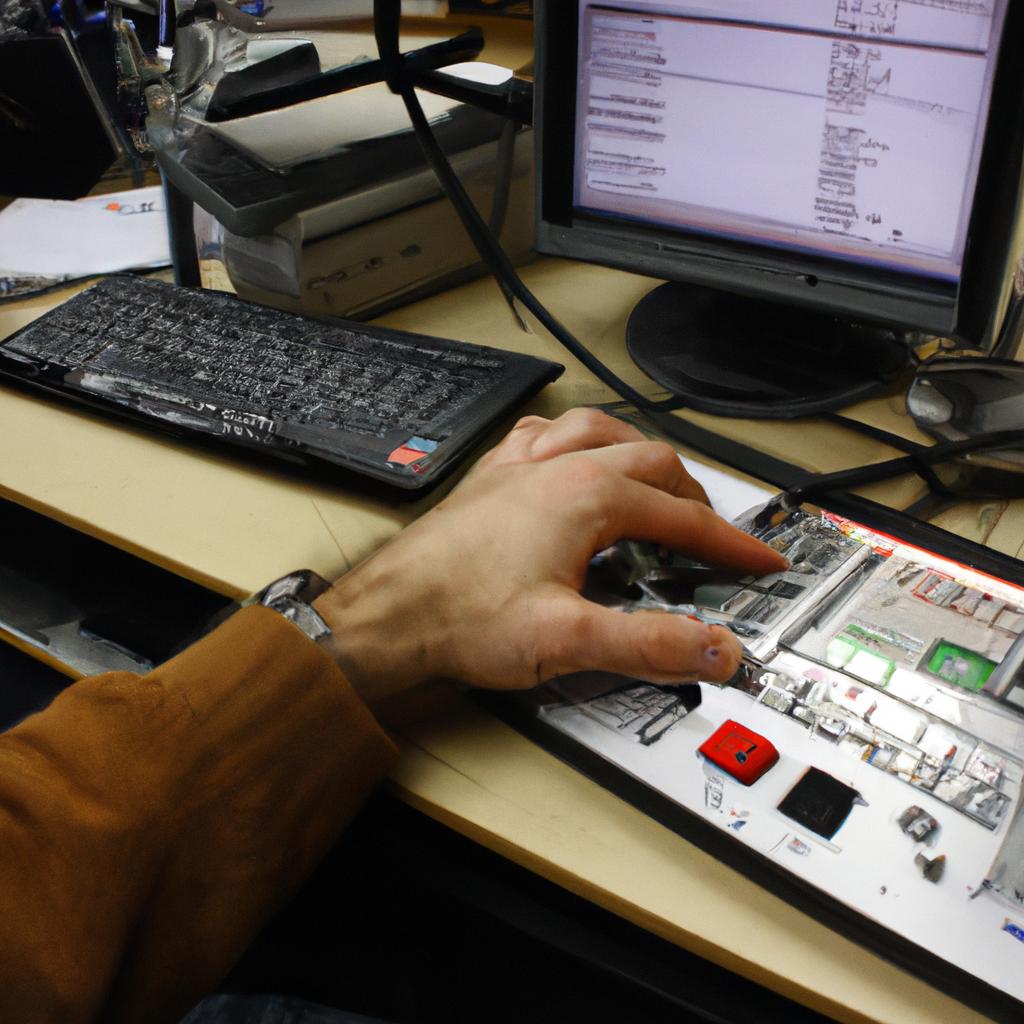Program-Associated Data (PAD) plays a crucial role in the world of radio and HD radio, providing additional information that enhances the listening experience for audiences. By incorporating data such as song titles, artist names, album covers, traffic updates, weather reports, and news headlines into radio broadcasts, PAD offers listeners a more comprehensive understanding of the content they are hearing. For example, imagine tuning into a radio station during your morning commute and being able to visualize current traffic conditions or receive real-time weather updates without having to divert your attention from driving. This hypothetical scenario highlights just one way in which PAD can greatly enhance the convenience and engagement of radio broadcasting.
In addition to its practical applications, PAD also holds significant implications for broadcasters and advertisers alike. With access to detailed audience analytics provided by PAD technology, broadcasters can gain valuable insights about their listeners’ preferences and behavior patterns. This knowledge allows them to tailor their programming and advertising strategies accordingly, maximizing their impact on target audiences. Furthermore, advertisers can leverage PAD data to deliver targeted advertisements based on specific demographics or geographical locations. As a result, both broadcasters and advertisers stand to benefit from improved audience engagement and increased revenue potential through the strategic utilization of program-associated data in radio broadcasting.
Overall, this article aims to explore the Overall, this article aims to explore the various benefits and possibilities that Program-Associated Data (PAD) brings to radio broadcasting, from enhancing the listening experience for audiences to providing valuable insights for broadcasters and advertisers.
Understanding Program-Associated Data
Program-associated data (PAD) plays a crucial role in radio broadcasting, providing additional information and enhancing the listener’s experience. For instance, imagine tuning into your favorite radio station during rush hour traffic and hearing an announcement about heavy congestion on your usual route. This real-time traffic update is made possible through PAD, allowing broadcasters to deliver valuable content beyond just audio.
To fully grasp the significance of PAD, it is important to understand its various applications. Firstly, PAD can be utilized to display song titles and artist names on compatible receivers, empowering listeners to identify and appreciate the music being played. By displaying this information, radio stations not only engage their audience but also promote the artists and songs they feature.
Secondly, PAD enables dynamic advertising opportunities for both local businesses and national brands. With the ability to transmit text or images alongside audio content, advertisers can create visually compelling ads that capture listeners’ attention. Imagine listening to your favorite morning show while driving past a billboard promoting a limited-time offer from a popular coffee shop chain – thanks to PAD integration, you could receive a visual representation of the promotion right on your receiver.
Moreover, the use of program-associated data allows for increased interactivity between broadcasters and their audience. Through interactive features such as polls or contests embedded within PAD-enabled broadcasts, listeners can actively participate in shaping programming decisions or even win prizes. This level of engagement fosters stronger connections between radio stations and their loyal followers.
In summary, program-associated data enhances the overall radio experience by providing supplementary information beyond traditional audio content. Whether it’s displaying song details, enabling dynamic advertisements, or fostering audience interaction through interactive features like contests or polls – PAD enriches the listener’s journey in unique ways. In the subsequent section discussing “The Role of Program-Associated Data in Radio Broadcasting,” we will delve deeper into how PAD influences broadcasting strategies and impacts HD Radio technology advancements.
The Role of Program-Associated Data in Radio Broadcasting
In the previous section, we explored the concept of Program-Associated Data (PAD) and its importance in radio broadcasting. Now, let us delve deeper into this subject by examining how PAD is utilized and why it plays a crucial role in enhancing the overall listener experience.
To illustrate the significance of PAD, consider the following hypothetical scenario: Imagine tuning in to your favorite radio station during your morning commute. As you listen to a popular talk show, relevant information such as song titles, artist names, upcoming events, and even traffic updates seamlessly appear on your car’s display screen. This additional data enhances your engagement with the program and provides valuable context that enriches your listening experience.
The integration of PAD into radio broadcasts offers several advantages for both broadcasters and listeners alike:
-
Enhanced Content Experience: By supplementing audio content with visual or textual information through PAD, listeners can gain a more comprehensive understanding of what they are hearing. This added layer of engagement not only captures attention but also helps retain important details.
-
Improved Accessibility: For individuals with visual impairments or language barriers, PAD can offer alternative ways to access content beyond traditional audio transmission. Text-based information allows them to stay connected with their favorite programs while ensuring inclusivity within the listener community.
-
Personalized Interactions: Through targeted advertisements, personalized recommendations based on listening preferences, and interactive features enabled by PAD technology, broadcasters have an opportunity to tailor their offerings according to individual tastes and interests. This personalization fosters a stronger connection between listeners and radio stations.
-
Real-Time Updates: With instant access to up-to-date news headlines, weather forecasts, sports scores, or emergency alerts via PAD-enabled radios or digital platforms like HD Radio, users can stay informed without having to switch devices or navigate away from their current broadcasted content.
To further emphasize these benefits visually:
| Benefits of Program-Associated Data |
|---|
| Enhanced Content Experience |
| Real-Time Updates |
In conclusion, Program-Associated Data plays a vital role in radio broadcasting by enriching the listener experience and providing additional context to audio content. Through features like enhanced content experiences, improved accessibility, personalized interactions, and real-time updates, PAD brings added value to radio broadcasts.
Enhancing the Listener Experience with Program-Associated Data
Imagine a scenario where you are driving in your car, listening to your favorite radio station. Suddenly, an advertisement comes on that catches your attention. It’s for a local restaurant offering a special discount on their signature dish. As the ad plays, additional information about the restaurant flashes across your car’s display screen – its location, hours of operation, and even customer reviews. This seamless integration of relevant data with the audio content is made possible by program-associated data (PAD), revolutionizing the way we experience radio broadcasting.
The incorporation of PAD in radio advertising has opened up new possibilities for engaging listeners and enhancing the effectiveness of marketing campaigns. Here are some ways in which program-associated data positively impacts radio advertising:
-
Personalized targeting: With access to demographic and behavioral data, advertisers can now target specific audiences based on their interests, preferences, and geographical locations. By tailoring advertisements to individual listeners or groups with similar characteristics, advertisers can increase relevancy and engagement.
-
Real-time updates: PAD allows for dynamic updates to be sent alongside regular programming, enabling advertisers to deliver timely messages such as limited-time offers or upcoming events. This real-time nature ensures that listeners receive accurate and current information at the right moment.
-
Interactive elements: Incorporating interactive elements into radio ads through PAD enables listeners to engage directly with brands. From participating in polls or surveys related to advertised products/services to entering contests via text messaging or app interaction, these interactive features create more immersive experiences between listeners and advertisers.
-
Measurable results: Traditional radio advertising has always faced challenges when it comes to measuring campaign success accurately. However, with PAD-enabled metrics like click-through rates or call-to-action response tracking, marketers gain valuable insights into listener behavior and campaign performance.
To further illustrate the impact of program-associated data on radio advertising strategies, consider Table 1 below:
Table 1: Case Study – Impact of Program-Associated Data on Radio Advertising
| Metrics | Before PAD Integration | After PAD Integration |
|---|---|---|
| Ad Relevance | Moderate | High |
| Listener Engagement | Average | Significant |
| Conversion Rates | Difficult to Track | Measurable |
As shown in the table, the integration of program-associated data significantly improves ad relevance, listener engagement, and measurable conversion rates. These positive outcomes underscore the transformative power of incorporating PAD into radio advertising strategies.
In conclusion, program-associated data has revolutionized radio advertising by enabling personalized targeting, real-time updates, interactive elements, and measurable results. The seamless integration of relevant data with audio content enhances the overall listening experience while providing advertisers with new opportunities for engaging their target audiences effectively. Moving forward, it is clear that program-associated data will continue to shape the future of radio broadcasting as we explore its full potential in delivering tailored and impactful content to listeners.
Next section: Program-Associated Data and the Future of Radio
Program-Associated Data and the Future of Radio
Imagine tuning in to your favorite radio station and, along with the familiar tunes, receiving real-time information about the artist currently playing or upcoming events related to their music. This is made possible through program-associated data (PAD), a technology that enhances the listener experience by providing additional content alongside audio broadcasts. In this section, we will explore how PAD enriches radio listening by offering relevant information and engaging features.
One example of how PAD can enhance the listener experience is through its integration with HD Radio. With HD Radio’s digital capabilities, broadcasters can transmit supplementary data such as album artwork, song lyrics, news updates, weather reports, traffic alerts, and even interactive advertisements directly to listeners’ receivers. This added layer of information not only keeps listeners informed but also engages them on a deeper level.
To illustrate the impact of PAD further, consider the following bullet points:
- Real-time artist and track information
- Dynamic album art display
- Interactive ads tailored to individual preferences
- Localized news and weather updates
Furthermore, it is essential to note that program-associated data isn’t limited solely to audio content; it can also be used for visual enhancements. For instance, imagine scrolling through an extensive catalog of available podcasts categorized by genre or subject matter right on your receiver’s screen. Such user-friendly interfaces enable seamless navigation and encourage exploration of diverse programming options.
The potential for utilizing PAD goes beyond mere entertainment value—it has significant implications for radio advertising as well. By leveraging personalized data collected from listeners—such as their preferred genres or past listening habits—advertisers can create targeted campaigns that resonate with specific demographics. We will delve into this aspect further in the subsequent section on “How Program-Associated Data Impacts Radio Advertising.”
In summary, program-associated data revolutionizes traditional radio broadcasting by providing real-time supplemental content and interactivity to engage listeners more deeply. Through technologies like HD Radio, listeners can enjoy enhanced experiences with features ranging from artist information to interactive ads. This integration of audio and visual elements amplifies the radio listening experience in a way that captivates audiences and offers them more control over their content consumption.
How Program-Associated Data Impacts Radio Advertising
Program-Associated Data (PAD) plays a significant role in revolutionizing the radio industry, particularly with the advent of HD Radio technology. This section will delve further into how program-associated data impacts radio advertising.
To illustrate this impact, let us consider a hypothetical scenario involving a popular morning talk show on a major FM station. The show often invites guests from various industries to discuss trending topics and share their expertise. With the implementation of PAD, listeners can now access detailed biographies of these guests, links to their social media profiles, and even exclusive promotional offers associated with their products or services through their HD Radio receivers.
The integration of PAD into radio advertising brings several benefits for both broadcasters and advertisers:
- Enhanced Engagement: By offering additional content via PAD, advertisers can engage audiences more effectively by providing supplementary information about their products or services beyond what is possible through traditional audio-only ads.
- Targeted Marketing: Utilizing demographic or geographic data available through PAD, advertisers can tailor their messages to specific audience segments, ensuring that they reach the right consumers at the right time.
- Interactivity: With interactive features enabled by PAD, listeners can actively participate in contests, polls, or surveys related to advertised brands or products directly from their HD Radio receivers.
- Measurable Results: Program-associated data allows broadcasters and advertisers to gather valuable insights regarding listener engagement levels, preferences, and response rates through analytics tools integrated into HD Radio platforms.
Table 1 showcases some potential applications of program-associated data in radio advertising:
| Application | Description |
|---|---|
| Real-time Offers | Instantly deliver personalized offers based on listener interests during ad breaks |
| Location-based Promotions | Provide location-specific promotions tailored to listeners’ geographical proximity |
| Brand Integration | Seamlessly integrate brands into radio programming through PAD, creating a more immersive and organic advertising experience |
| Targeted Messaging | Deliver targeted messages to specific listener segments based on demographic or psychographic data |
While the integration of program-associated data in radio advertising brings numerous advantages, it is essential for broadcasters and advertisers to strike a balance between providing relevant content and maintaining listeners’ trust. Overwhelming audiences with excessive promotional material may lead to diminished engagement and even alienation.
As we move forward, exploring the technical aspects of program-associated data in radio will shed light on how this technology functions behind the scenes and further elucidate its impact on the industry’s future development.
[Transition] With an understanding of how program-associated data impacts radio advertising, let us now delve deeper into exploring the technical aspects of program-associated data in radio.Exploring the Technical Aspects of Program-Associated Data in Radio
Building upon the understanding of how program-associated data impacts radio advertising, it is essential to delve into the technical aspects that make this integration possible. By exploring the underlying mechanisms and intricacies involved, we can gain a comprehensive perspective on the significance of program-associated data in radio.
Program-associated data allows for seamless integration of additional content within broadcasts, enhancing the listening experience for audiences. For instance, consider a scenario where a local radio station is hosting a live music event. Through program-associated data, listeners can receive real-time updates about the event’s schedule, artist lineup, and ticket availability directly on their HD Radio receivers or other compatible devices. This additional information not only enriches their engagement but also creates opportunities for enhanced audience interaction and participation.
To better understand the technical aspects at play with program-associated data in radio broadcasting, let us explore some key components:
-
Metadata: Metadata provides detailed information about each audio segment being broadcasted. It includes details like song title, artist name, album cover art, genre classification, and even lyrics. Such metadata facilitates automatic display of relevant information on receiver screens or mobile applications.
-
Dynamic Content Insertion: With dynamic content insertion capabilities enabled by program-associated data technology, broadcasters have the flexibility to seamlessly insert targeted advertisements during breaks without interrupting regular programming flow. This ensures advertisers reach their intended audiences effectively while maintaining an engaging listener experience.
-
Conditional Access System (CAS): CAS enables secure transmission of digital content through encryption methods such as HDCP (High-bandwidth Digital Content Protection). It ensures that copyrighted material remains protected against unauthorized access or distribution.
-
Error Correction Mechanisms: To maintain high-quality reception despite potential signal interference or degradation due to atmospheric conditions or physical obstacles, error correction mechanisms are employed in transmitting program-associated data over-the-airwaves. These mechanisms help ensure reliable delivery of data, minimizing the chances of information loss or corruption.
Embracing program-associated data in radio broadcasting unlocks a realm of possibilities for both broadcasters and listeners. By seamlessly integrating additional content, such as real-time event updates or enriched metadata, it enhances audience engagement and interactivity. Understanding the technical aspects involved, from metadata to error correction mechanisms, empowers broadcasters to leverage this technology effectively and provide an enhanced listening experience.
 K7BUC
K7BUC



